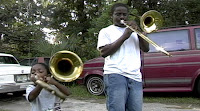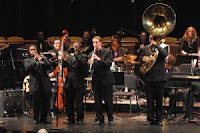
(Note: Family business will probably preclude blogging until Mon. In the meantime, check out some live music. Again, here are some suggestions.)
Havana Centro
Directed by Paul Johnson
pauljohnsonfilms.com
When looking at Cuba, what some see as privation and desperation, others chose to see through their ideological prism as old world charm. Yet the music of the Caribbean Island has a seductive hold on partisans of each side. Paul Johnson’s short documentary, Havana Centro, now available on DVD after making the festival circuit, offers a glimpse at the every day musical lives of Cubans, largely free of commentary, allowing viewers to draw their own conclusions.
Of course, the realities of Cuba’s police state are inescapable, as director Paul Johnson acknowledges. His opening narration states:
“And hope in Cuba is not an impossible concept, just a complicated one. In Fidel Castro’s Cuba your life is largely regulated by the whims of the revolution. You may have little choice in where and how you live, and what you do. But in music, there is ultimate freedom, which may explain why this small nation, even under Communism, remains one of the most powerful musical cultures in the world.”
Music is, in fact, the focus of Centro. Viewers are offered samples of a son ensemble, Santeria rituals, an impromptu rooftop salsa party, and the Afro-Cuban jazz of conguero Joaquin Pozo’s group Latin Millenium. Although, Pozo’s band is not heard in full performance, the partial clips suggest they are a worthy group. Johnson’s commentary again is on point when he suggests: “Their Afro-influenced jazz may be the perfect genre for transmitting the angst of a people who have been restrained for centuries, whether by slave-traders or Communist dictators.”
Johnson does use indeed use terms like dictatorship to describe the political situation in Cuba. However, there are some moments that would make the distinguished bloggers of Babalu cringe. Johnson essentially passes along the myth of the mighty Cuban healthcare system and asserts that despite the widespread poverty, “Cubans don’t lack the basic necessities though.” This is not necessarily born out by the recent documentary East of Havana, in which one of the young rapper’s mother jokes about often cooking entire meal from three garlic cloves.
When examining conditions of the city’s architecture, Johnson finds the buildings “in a continual state of decay or repair—it’s hard to tell which.” In fact, every structure seems to be crumbling to its foundations, yet Havana retains its romantic appeal. Much in Centro seems open to interpretation. The National Hotel is introduced as a “great showcase of the rich cultural current running through Havana.” However, video of veterans of the once prohibited Buena Vista Social Club taking picture after picture with European tourists may speak to others of the exploitative nature of Cuba’s tourism industry.
While short and simple, the strength of Centro is that for the most part, it records Havana’s music and images, leaving the interpretation up to viewers. It would be nice to see this film picked up by PBS, and I’d also be interested in seeing a Babalu review.
Havana Centro
Directed by Paul Johnson
pauljohnsonfilms.com
When looking at Cuba, what some see as privation and desperation, others chose to see through their ideological prism as old world charm. Yet the music of the Caribbean Island has a seductive hold on partisans of each side. Paul Johnson’s short documentary, Havana Centro, now available on DVD after making the festival circuit, offers a glimpse at the every day musical lives of Cubans, largely free of commentary, allowing viewers to draw their own conclusions.
Of course, the realities of Cuba’s police state are inescapable, as director Paul Johnson acknowledges. His opening narration states:
“And hope in Cuba is not an impossible concept, just a complicated one. In Fidel Castro’s Cuba your life is largely regulated by the whims of the revolution. You may have little choice in where and how you live, and what you do. But in music, there is ultimate freedom, which may explain why this small nation, even under Communism, remains one of the most powerful musical cultures in the world.”
Music is, in fact, the focus of Centro. Viewers are offered samples of a son ensemble, Santeria rituals, an impromptu rooftop salsa party, and the Afro-Cuban jazz of conguero Joaquin Pozo’s group Latin Millenium. Although, Pozo’s band is not heard in full performance, the partial clips suggest they are a worthy group. Johnson’s commentary again is on point when he suggests: “Their Afro-influenced jazz may be the perfect genre for transmitting the angst of a people who have been restrained for centuries, whether by slave-traders or Communist dictators.”
Johnson does use indeed use terms like dictatorship to describe the political situation in Cuba. However, there are some moments that would make the distinguished bloggers of Babalu cringe. Johnson essentially passes along the myth of the mighty Cuban healthcare system and asserts that despite the widespread poverty, “Cubans don’t lack the basic necessities though.” This is not necessarily born out by the recent documentary East of Havana, in which one of the young rapper’s mother jokes about often cooking entire meal from three garlic cloves.
When examining conditions of the city’s architecture, Johnson finds the buildings “in a continual state of decay or repair—it’s hard to tell which.” In fact, every structure seems to be crumbling to its foundations, yet Havana retains its romantic appeal. Much in Centro seems open to interpretation. The National Hotel is introduced as a “great showcase of the rich cultural current running through Havana.” However, video of veterans of the once prohibited Buena Vista Social Club taking picture after picture with European tourists may speak to others of the exploitative nature of Cuba’s tourism industry.
While short and simple, the strength of Centro is that for the most part, it records Havana’s music and images, leaving the interpretation up to viewers. It would be nice to see this film picked up by PBS, and I’d also be interested in seeing a Babalu review.






















